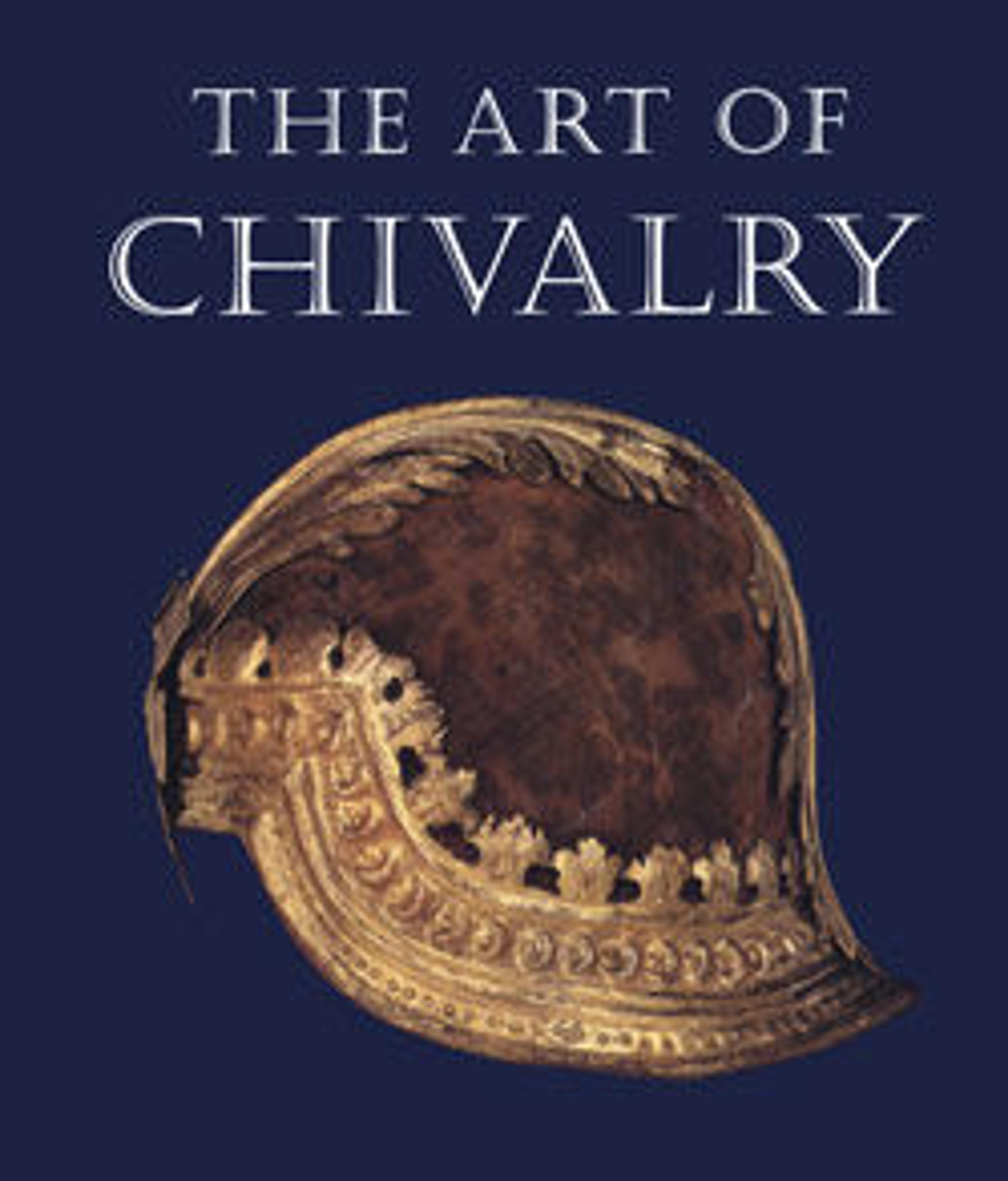Glaive of the Bodyguard of Giovanni Battista Bourbon del Monte (1541–1614)
The long, knife-like blade has a convex cutting edge and flat back sharpened near the tip, with two molded spikes at the base. The back edge terminates in an ornamental scroll in the form of a dolphin, and a long, upward-curving parrying spike projects at an acute angle from the back. The lower half of the blade is etched on either side with a decorative cartouche enclosing the arms of Bourbon del Monte (azure, three fleurs-de-lis or, with a bend, gules overall), surmounted by a seven-pointed crown, above a figure of a warrior in Roman armor. The octagonal socket and the side straps are etched with strapwork, rosettes, and tiny figures of warriors within oval medallions. The wooden shaft of flattened octagonal section is studded with gilt-brass nail heads beneath which are traces of the original fabric covering.
Italian staff weapons of this particular type, variously called fauchards in French, falcioni in Italian, are basically the same weapon as the German Kuse (see acc. nos. 04.3.97 and 25.188.18), but with the addition of a decorative spike on the back edge and two short spikes or lugs at the base of the blade. Like the Kuse, these glaives were carried by palace guards and, judging from the large number decorated with the arms of Venetian families, were particularly favored in Venice.
This example is one of eleven similar glaives from the Duc de Dino collection which bear the heraldic arms of the ancient Tuscan family Bourbon del Monte, marquises of Monte Santa Maria. However, the similarity of the del Monte arms with those of the cadet branch of the French Bourbon family lead Cosson in 1901 to identify these glaives as French and made for the bodyguard of Louis II de Bourbon, Duke of Montpensier (1513–1582). This error was perpetuated in arms and armor literature for seventy-five years, until corrected by L. G. Boccia. Giovanni Battista Bourbon del Monte (1541–1614) had a long military career in which he served in Africa, France, and Flanders, as well as in Italy. In 1587, Giovanni Battista entered venetian services as captian-general of the infantry and inspector of fortresses on the mainland. These glaives, so common in Venice, were therefore probably carried by Giovanni Battista's Venetian bodyguard.
The Metropolitan Museum possesses a fragmetnary amor of Giovanni Battista Bourbon del Monte (acc. no. 14.25.710) which also dates to about 1590, during the period of his Venetian service. The armor and the series of glaives bearing the del Monte arms were quite possibly made in Brescia, chief supplier of arms to the Venetian Republic.
Italian staff weapons of this particular type, variously called fauchards in French, falcioni in Italian, are basically the same weapon as the German Kuse (see acc. nos. 04.3.97 and 25.188.18), but with the addition of a decorative spike on the back edge and two short spikes or lugs at the base of the blade. Like the Kuse, these glaives were carried by palace guards and, judging from the large number decorated with the arms of Venetian families, were particularly favored in Venice.
This example is one of eleven similar glaives from the Duc de Dino collection which bear the heraldic arms of the ancient Tuscan family Bourbon del Monte, marquises of Monte Santa Maria. However, the similarity of the del Monte arms with those of the cadet branch of the French Bourbon family lead Cosson in 1901 to identify these glaives as French and made for the bodyguard of Louis II de Bourbon, Duke of Montpensier (1513–1582). This error was perpetuated in arms and armor literature for seventy-five years, until corrected by L. G. Boccia. Giovanni Battista Bourbon del Monte (1541–1614) had a long military career in which he served in Africa, France, and Flanders, as well as in Italy. In 1587, Giovanni Battista entered venetian services as captian-general of the infantry and inspector of fortresses on the mainland. These glaives, so common in Venice, were therefore probably carried by Giovanni Battista's Venetian bodyguard.
The Metropolitan Museum possesses a fragmetnary amor of Giovanni Battista Bourbon del Monte (acc. no. 14.25.710) which also dates to about 1590, during the period of his Venetian service. The armor and the series of glaives bearing the del Monte arms were quite possibly made in Brescia, chief supplier of arms to the Venetian Republic.
Artwork Details
- Title: Glaive of the Bodyguard of Giovanni Battista Bourbon del Monte (1541–1614)
- Date: ca. 1590–1600
- Geography: Brescia
- Culture: Italian, Brescia
- Medium: Steel, wood, gold, brass, textile
- Dimensions: L. 99 3/4 in. (253.37 cm); L. of head (excluding straps) 35 in. (88.9 cm); L. of blade 30 in. (76.2 cm); greatest W. 5 3/4 in. (14.61 cm); Wt. 6 lb. (2722 g)
- Classification: Shafted Weapons
- Credit Line: Rogers Fund, 1904
- Object Number: 04.3.89
- Curatorial Department: Arms and Armor
More Artwork
Research Resources
The Met provides unparalleled resources for research and welcomes an international community of students and scholars. The Met's Open Access API is where creators and researchers can connect to the The Met collection. Open Access data and public domain images are available for unrestricted commercial and noncommercial use without permission or fee.
To request images under copyright and other restrictions, please use this Image Request form.
Feedback
We continue to research and examine historical and cultural context for objects in The Met collection. If you have comments or questions about this object record, please complete and submit this form. The Museum looks forward to receiving your comments.
